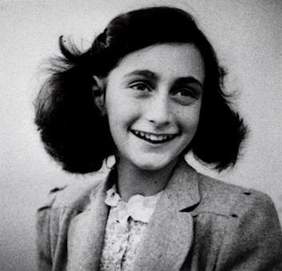they came on a warm, sunny day
They came on a warm, sunny Friday in August 1944. The Gestapo and Dutch police tipped off about a family of Jews hiding in the upstairs rooms of Prinsengracht 263.
 It took them two hours, but they finally found the two Jewish families. Only Otto, the father survived the horror of the concentration camps. Anne, and her sister, Margot, who had lived for two years in the secret annex, a romantic name for some small concealed rooms behind a bookcase – died, probably from typhus, in the Bergen-Belsen concentration camp.
It took them two hours, but they finally found the two Jewish families. Only Otto, the father survived the horror of the concentration camps. Anne, and her sister, Margot, who had lived for two years in the secret annex, a romantic name for some small concealed rooms behind a bookcase – died, probably from typhus, in the Bergen-Belsen concentration camp.
She probably gave in sometime in February 1945. No accurate records mark her death. Like thousands of others, one day she was there, then she wasn’t. I had read her story, “The Diary of a Young Girl”, many years before in a place so different, so uncoupled from this place in history.
I had grown up in a white, Christian town, surrounded by the scots brand of Presbyterianism, the dour, austere kind. There was no connection with the events in the diary. You could not imagine the depth of evilness needed for this. Such shadows did not intrude into my childhood.
My world was surrounded by eucalypts, wheat fields and endless summer days. Now I stood in the secret annex where Anne Frank and her family hid for two years – hiding their Jewishness from the occupying Germans. It’s near central Amsterdam, now it’s a museum, a monument to one of the world’s most famous diarists and on the top of every tourist’s must-see list. So you queue up and wait in the European cold – the sort of cold that sneaks up on you, like the cyclists that shoot by you with nary a sound, until suddenly you are chilled to the bone. Wait, shuffle, wait, shuffle. Then you are there, in the secret hiding place. It is empty and barren, just as Otto Frank found it on his return. The Nazis left nothing.
It’s a small, confronting, claustrophobic place reducing you to tears. If you stand still and lean against the wall in these bleak, barren, rooms, ignoring the chattering tourists and listen, and I mean REALLY listen, you can hear the sounds of the madness, the tramping of the boots coming closer and closer, you can hear the sounds of approaching death, the screeching of tyres, slamming of truck doors, the yelled commands, the tramp of boots on the cobblestones, the smashing of timber.
You can hear, feel and smell the fear that swarmed through these rooms on that warm sunny Friday. The annex represented safety, hope, resistance. Amsterdam had a Jewish population of more than 107,000 before the German occupation.
In the end, Otto Frank was one of about 5000 that survived. They were just numbers before, but in the secret annex, they are people. So you lean there, wondering what it was that had driven the world so mad, made evil so acceptable. It is beyond my comprehension – I had read the books, seen the films of the horrors of the concentration camps, had studied it at the university.
But being here, listening hard, being involved took it from the abstract to real fear, real people, real deaths. Ninety-three-year-old Stanisław Aronson, who took part in the Polish resistance under Nazi occupation and now lives in Israel, said of the madness that swept Europe: “If disaster comes, you will find that all the myths you once cherished are of no use to you. You will see what it is like to live in a society where morality has collapsed, causing all your assumptions and prejudices to crumble before your eyes. And after it’s all over, you will watch as, slowly but surely, these harshest of lessons are forgotten as the witnesses pass on, and new myths take their place.”
Then you are back on the street, near the canal, wondering if the world had really learnt anything.
These are my stories. Some might even be true.


Comments